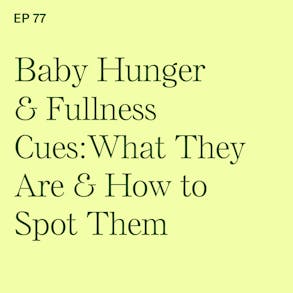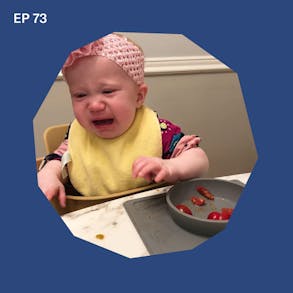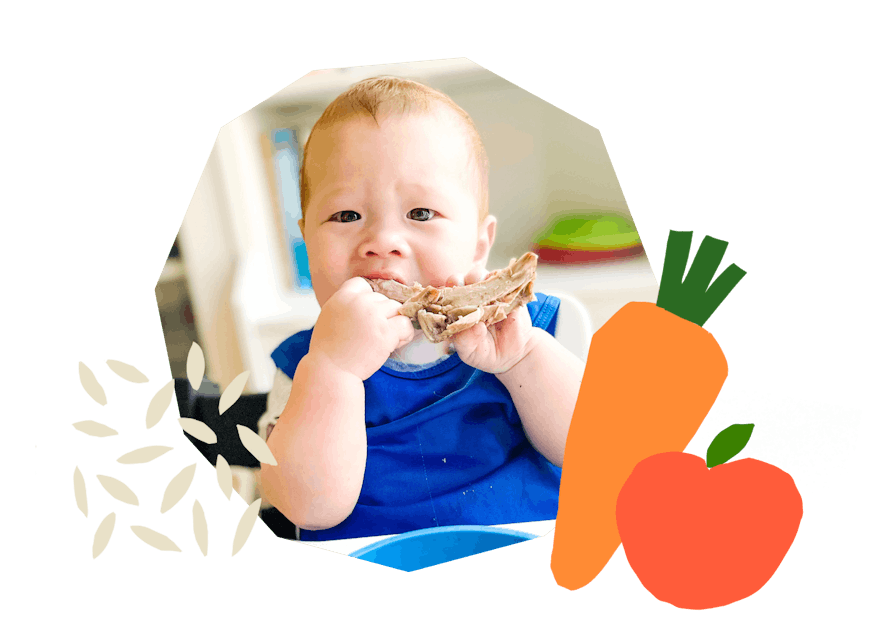Liver: How to Offer Liver Safely to Babies
- Why even if you don't personally love liver, it's still a great food to feed to your baby
- How to choose what liver to serve...and why you might want to give chicken livers a second look
- When it's safe to feed your baby and how much is ok to serve each week

LISTEN TO THIS EPISODE
Episode Description
If you’re not a liver lover, then you need to listen to this episode! Liver is one of the most nutrient rich foods you can feed your baby. It’s packed with iron and fat-soluble vitamins, not to mention a really unique taste and texture experience for your baby.
But how do you make liver safe for babies to eat? And how much and what type of liver is best for babies? In this episode we’re talking all about liver: what type of liver, how to prepare it, when it’s safe to feed babies and how much they can have.
Links from this Episode
- Baby-Led Weaning with Katie Ferraro program with the 100 First Foods™ Daily Meal Plan, join here: https://babyledweaning.co/program
- Baby-Led Weaning for Beginners free online workshop with 100 First Foods™ list to all attendees, register here: https://babyledweaning.co/baby-led-weaning-for-beginners
Other Episodes Related to this Topic
- Episode 21: 3 Easy Ways to Boost Your Baby's Iron Absorption is available here

Latest Episodes






Katie Ferraro (1s):
And I know the thought of liver to so many of you is like utterly revolting, but for babies, it's amazing. Such a cool texture experience. Nutrient dense iron in there, especially chicken livers. So highly bioavailable. Babies love litter. Hey, there I'm Katie Ferraro, registered dietician, college nutrition professor, and mom of seven specializing in baby-led weaning here on the Baby-Led Weaning Made Easy podcast. I help you strip out all of the noise and nonsense about feeding, leaving you with the competence and knowledge you need to give your baby a safe start to solid foods using baby-led weaning. Hey there, welcome back today.
Katie Ferraro (42s):
We're talking about one of nature's most iron rich, most nutrient rich food sources out there, and that is liver. Now, before you tune out, because you're may be grossed out by the sound of liver, just hear me out because liver is a fabulous food for baby-led, weaning and babies love it. So I'm going to share a few tips on how to safely prepare liver for baby-led weaning, because I know for a lot of us depends upon your food culture, but liver is maybe a sometimes food or a food that you're not normally or routinely preparing for your baby or purchasing. So we're going to chat about how to do that. So before we get started on these little mini baby-led weaning training episodes, I like to share a BLW tip of the day and today's tip is going to be about butter.
Katie Ferraro (1m 25s):
Now, as we all know, butter makes everything better, but it certainly makes liver better. I feel like I prepared liver like a ton of different ways and times for babies over the years. But let me just say that when you fry it in butter, well, it's one of the few ways that I'll personally live liver. Most adults. I know feel the same babies love it too. So with butter though, I want you to just keep in mind that butter is a dairy food it's made from cow's milk, which is one of the potentially allergenic foods. And there's nothing wrong with that. We just want to make sure that your baby has been exposed to dairy foods on their own without reaction. A number of times before you were to let's say, try out liver as a new food and butter as a new food at the same time. So do the dairy foods ahead of time on their own, and then loop liver in, but use some butter.
Katie Ferraro (2m 6s):
So liver does well with butter, but I've got a few more ideas about how we can offer liver safely to babies using baby-led weaning. So let's start out with what liver actually is. Now. There is this like popular objection to eating liver where people believe that while liver's a storage organ for toxins in your body. So if you eat it, it could be potentially toxic. And yes, it's true. One of liver's roles is to neutralize toxins like drugs and chemical agents poisons in the body, but it doesn't store those toxins. And so liver, if you're eating liver, it doesn't necessarily mean you're ingesting the stored toxins because your body continues to excrete them. But liver is in many regards, a storage organ for a lot of important nutrients like vitamins, A, D, E and K.
Katie Ferraro (2m 48s):
Those are the fat-soluble vitamins, vitamin B12 and folic acid, and there's minerals like copper and iron. So as a result, liver tends to be one of the most nutrient dense sources of many of these vitamins and minerals that you can find anywhere. Talk a little bit about the types of liver that you might be selecting. If you're at the store in a typical grocery store. I know my grocery store I'm in Southern California. I can generally find cow liver pretty routinely chicken livers, less so, but it depends what sort of market I'm at. If I'm at a Mexican market or certain Asian markets, I may be able to find certain types of liver that I couldn't at just your more traditional grocery stores, regardless. You can almost always find liver cow liver. Interestingly enough has less iron than chicken liver.
Katie Ferraro (3m 29s):
There's almost four times more bioavailable liver in chicken than you find in cow's liver or beef liver. Now, why would you want to eat liver? Well, it's incredibly nutrient dense. A single serving of liver has a hundred percent of your daily value or vitamin a it's high in protein. I mean, it's low in calories. It's got all these other important nutrients like I've already mentioned, but iron is what we're really honing in on here for babies. That chicken liver iron, that I mentioned is actually the most bioavailable type of iron you can eat. And also as interestingly enough, a pretty decent amount of vitamin C, which is pretty rare in meats, organ meats, which of course liver is and liver, because it is a type of animal protein also contains all nine essential amino acids.
Katie Ferraro (4m 13s):
So from a nutrition standpoint, if you want to get a little bit nerdy, liver is a really important food. Now, if we're talking about what different types of liver you can get, I mentioned chicken liver image in cow's liver, beef liver, there's pork liver out there. You can get sardines, turkey liver. I mean, pretty much any animal out there. You can find their livers. Depends what market, again, that you're shopping. As for the timing. When do we want to feed baby's liver? Well, it is one of the most nutritious foods that you can feed a baby. And when your baby is six months of age, plus show any other signs of readiness to feed, it is fine to give your baby liver. As far as the amounts go, I do recommend limiting liver to about one serving per week. Generally when we offer new foods to babies, we're doing one new food a day.
Katie Ferraro (4m 55s):
If you're following my five-step feeding framework, you introduce that new food to the baby that day. And then in the second half of your feed, you introduce the new food from that day plus two previous days foods. So in that way, generally introducing and reintroducing familiar foods on top of new foods. But with liver, I don't do it like over and over and over again, just because of the very slim potential for toxicity. Now, the actual like risk are you going to have very toxic levels of vitamin a or other potential toxins, et cetera. There really is no data to support that notion. If we actually look at reported incidences, let's say a vitamin A toxicity, and there's one study we were looking at in preparation for this episode where there were fewer than 10 reported cases over a period of 11 years.
Katie Ferraro (5m 37s):
So unlikely that your baby's gonna overdose on liver, but just to be on the safe side, keep it to one serving a week. And again, it's not like a massive, widespread public health problem where babies are like having problems with liver, but you know, just don't feed it at perhaps as often as you might some of the other new foods, you know, how do you feed liver? Okay. Personally, I'm not very or adventurous with my liver preparation methods. I just fried in butter. Now this doesn't need a ton of explaining, but I do wash the liver pretty well. I remove trim any visible fat I'd pat it dry. You can cut the liver into pieces or strips about the size of your head, pinky finger, heat, butter, or olive oil. I think butter tastes a lot better over medium heat, and then just fry that liver until it's light brown on each side, you don't want to have it be crispy or crunchy.
Katie Ferraro (6m 20s):
We don't feed foods like that to baby. You could also saute onions in it or add some other seasonings. If you want liver off sometimes is cooked with ingredients like mushrooms or wine cream or onion. So yeah, you can do with mustard. You can fry it with garlic sauce, tomato sauce with all of us. What have you obviously try to keep the sodium low if you can, but it is perfectly fine to add seasoning and spices to your baby's foods. Another easy way to do liver for baby-led weaning is to actually grind the liver in a food processor and then make a Patty out of it with a combination of ground beef and ground levers. So I'll do like three parts, ground beef to one part grounded, or make little patties, fry them up, cut them into strips, serve it to the baby. Could also make it into a patte.
Katie Ferraro (7m 0s):
You can sometimes find liver patte at the grocery store. They just tend to have a lot of added salt. We really want to minimize salt as much as possible. Well, so it's probably a bit on the safer side to be making or yourself at home without significant amounts of added salt. There are many different ways to prepare liver, dependent upon what your food culture is in Mexico. For example, there's popular recipes that include beef sliver in onions. There's a dish that repairs beef liver and tomato stew chicken there's might be added to rice or cooked into stews and other parts of Mexican food culture in Germany, liverwurst it's made of pig or calves liver. In Lebanon lamb liver is considered to be a delicacy. It can often be eaten for breakfast or raw.
Katie Ferraro (7m 40s):
Certainly wouldn't serve raw protein foods of any type to babies, but in Lebanon, it can be served with dice fat tail and spices, white pepper and cayenne sumac, cumin, coriander, salt. Again, we don't add a ton of salt for babies, but just, don't be scared to be creative with doctoring up the liver to make it taste like however, the liver dish that you're trying to prepare, you want it to be that Lebanese liver, then it's dipped oftentimes in the spices and then placed on a piece of pita bread. You can, or can't feed pita bread depends upon your baby older babies. I do feel comfortable with bread, just keeping in mind again, though, that there tends to be a lot of salt in commercially prepared bread as well. In the Philippines, there's a dish called higado, derived from the Spanish word for liver, which is higado.
Katie Ferraro (8m 22s):
The liver is sauteed with garlic and onions and then simmered in soy sauce and vinegar kind of akin to many other Filipino dishes. So lots of ways to offer liver to your baby, make sure it's cooked all the way through. You want to make sure that it's soft, make sure that it's in strips, that the baby can pick it up and sell feed. That can be a little bit tricky with chicken livers, which tend to be small or in size, but you can get to a point where a baby can eat them. And again, an incredibly nutrient rich option for baby-led weaning. Well, I hope you guys enjoyed that podcast all about how to offer liver safely to your babies. I know liver is one of those like kind of sometimes foods that we're not all super familiar or comfortable with, but it's super nutrient dense. It's a really cool flavor experience for your baby. It's also got a brand new texture for them.
Katie Ferraro (9m 3s):
So, you know, give liver a second look. And I know it's not one of the most common foods that babies can eat, but there's certainly no reason why. Especially even early eaters, six months of age, showing the other signs of readiness to feed, you can do liver safely for them because our babies can eat so many more foods than we give them credit for. I actually created a whole approach called the a hundred first foods approach to show you how your baby can eat a hundred different foods before they turn one. If you're interested in grabbing my hundred first foods list, I give it away to everybody on my baby-led weaning for beginners workshop. This is a free online workshop that shows you how you can get your baby to try 100 foods before turning one, without you having to spoonfeed purees or buy pouches, right?
Katie Ferraro (9m 47s):
Cause that's not how we do liver. We serve babies real food, and they could eat so many more real foods than we give them credit for. So if you want to grab my hundred first foods list again, come sign up for the baby-led weaning for beginners workshop. I'll put a link to this week's workshop times in the show notes. At this episode, if you go to blwpodcast.com/103, you can get signed up for the baby-led weaning for beginners workshop. Come grab the a hundred first foods list. I'm going to walk you through all the basics of starting out. And I also do a Q and A at the end of the workshop too. So if you have any like burning baby-led weaning questions, I'm there to answer them for you as well. So check it out. at blwpodcast.com/103, and maybe I'll see you inside of the workshop.
Katie Ferraro (10m 30s):
Bye now.

The Program Baby-Led Weaning with Katie Ferraro
A step-by-step digital program for starting solid foods safely and navigating the original 100 FIRST FOODS™ meal plan with baby-led weaning.
 EXPERT-LED, PROVEN APPROACH TO EATING REAL FOOD
EXPERT-LED, PROVEN APPROACH TO EATING REAL FOOD CONCISE VIDEO TRAININGS TO MASTER BABY-LED WEANING
CONCISE VIDEO TRAININGS TO MASTER BABY-LED WEANING 100 FIRST FOODS DAILY MEAL PLAN WITH FOOD PREP VIDEOS
100 FIRST FOODS DAILY MEAL PLAN WITH FOOD PREP VIDEOS
Baby-Led Weaning for Beginners Free Workshop
Is your baby ready to start solid foods, but you’re not sure where to start? Get ready to give your baby a solid foundation to a lifetime of loving real food…even if you’re feeling overwhelmed or confused about this next stage of infant feeding.
Get baby-led weaning recipes and tips delivered to your email inbox.

